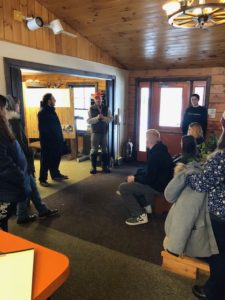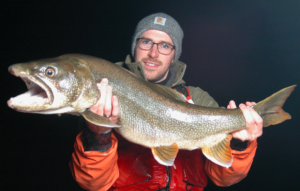Most shotgun deer hunters hoped that they would be dragging their deer out of the woods last Monday morning. Sadly, many couldn’t even get out of their driveways because of the heavy snow that fell the previous day and earlier that morning. Many spent the entire morning clearing their driveways of snow. Too bad for those hunters who took the day off from school or work to go hunting on opening day. Oh well, some thought, they will go hunting on Tuesday. Well, as you know, it was déjà vu with even more snow to clear.
Some hearty souls were able to get out, but with nearly 2 feet of snow in some areas, the walking was tough. Many hunters felt that the deer weren’t moving and just hunkered down for the duration of the storm. Some deer were taken, but the overall deer count was considerably lower than other opening days.
By noontime on Wednesday, 45 or so deer were checked at the DFW Western Regional Headquarters in Dalton. In a normal year, they would have checked 50 deer on Monday alone. A couple of nice deer had been checked in at that time; one was a 206 lbs, 8-point buck taken by Aaron Rocha. Another was a 161 lbs, 12-point buck taken by Joe Hinckley. A black bear was also checked in.
As of mid-afternoon on Wednesday, only 1 deer had been checked in at the Becket General Store. The deep snow was also blamed for the low count, but this was the first year that the store restarted checking in deer and perhaps few hunters were aware of it.
Some 52 deer had been checked in at the Mill River General store as of Wednesday afternoon, which, according to DFW Biologist Nate Buckhout is about half of the normal count. A lot of those hunters had to work, plowing and sanding driveways. The largest deer so far checked in was a 176 lbs, 7-point buck which was taken in Great Barrington. A 150 lbs doe (which is a huge doe) was taken in Sheffield. Two black bears were also checked in.
By the way, all deer weights were field dressed weights.
At the Lee Sportsmen’s Association, some 21 deer had been checked in, at Ernie’s Auto Sales in North Adams, 39 deer and at Papa’s Healthy Food & Fuel in Otis 17 deer were checked in. No detail information was provided on these last three check stations.
As previously suggested, blame the snow for the lower counts on Monday and Tuesday, but I suspect the hunting got better as the week progressed.
While at the DFW Western Regional Headquarters in Dalton getting the deer count, I found District Supervisor Andrew Madden surrounded by a group of Wahconah High School students accompanied by Wahconah Environmental teacher April Lesage. The youths were part of the 50 or so students (three classes) in its Environmental Science Program. 
Andrew gave them lots of information about deer, deer hunting, what DFW’s role is in all of it and other information. If kids were interested in deer hunting (and there were a few) he encouraged them to take a hunter education course. The boys and girls were very interested in what he had to say. They had the added thrill of seeing a deer being weighed and aged while they were there. Too bad they had to leave when they did for shortly thereafter a black bear was checked in.
Madden mentioned that 4 classes of BCC students also visit during the first week of shotgun deer season. He gets into the subject a little deeper with them discussing such things as deer population management.
2019 lake trout survey
Each fall, MassWildlife samples the Quabbin and Wachusett Reservoirs to monitor lake trout populations. With the help of DCR, MassWildlife surveys lake trout to examine population characteristics. The 2019 fall sampling is complete and crews on Wachusett Reservoir captured and released 142 lake trout including a 37-inch, 18-pound fish.
Crews at Quabbin Reservoir captured and released 130 lake trout, 34 at Goodnough Dike and 96 at Windsor Dam. The largest lake trout encountered was originally tagged in 2015 and then recaptured in 2017. That fish, pictured above, measured 33.5 inches and 13.3 pounds. In addition to lake trout, several large landlocked salmon were captured at Quabbin weighing between 6 and 7 pounds. 
To capture lake trout, field crews set nets on spawning areas starting at sunset and check them about every 20 minutes. Captured fish are removed from the nets and placed in a livewell. Next, biologists record length, weight, and sex and implant a small Passive Integrated Tag (PIT) in the fish. Prior to release, the adipose fin is clipped to provide an external mark indicating that the fish has been captured before. Data collected provide biologists with an understanding of the current condition of lake trout populations. If fish are recaptured from previous tagging efforts, biologists can calculate individual growth rates. Lake trout are long lived and slow growing and it is not uncommon for a tagged fish to be recaptured 10 years later. In fact, the longest recapture interval recorded was 24 years! When other species like landlocked salmon, smallmouth bass, rock bass, and white perch are captured, biologists record information including length, weight, and sex but do not implant PIT tags.
Lake trout typically spawn in late October and November when the surface water temperatures are around or below 50°F. The spawning grounds are typically shallow, rocky waters on windy shores of the Reservoirs; spawning occurs mostly after dusk. Night sampling on big waters can be cold and icy in November, but the information it provides biologists is well worth the effort.
New book out entitled Surfcasting Block Island and Cuttyhunk
Hot off the press, this is the fifth and latest book on striped bass fishing by D.J. Muller. It is a detailed guide to two legendary surfcasting destinations which are considered home to some of the best striped bass fishing in the world.
Block Island, just off of the coast of Rhode Island, is 7 miles long and 3 miles wide. It has some of the richest varieties of surfcasting venues from sand beaches to boulder fields. Muller explicitly details 24 good surfcasting areas on the island (He even provides a map) explaining in detail how to get to them, where to park, what type waters the angler will encounter, when to fish them, what rods, reels and lures to use and more.
He gets into wetsuit fishing off of boulders at night. He related some of his scary experiences such as being washed off of the boulders by large waves, being caught in thick fog at night with no waves hitting the shores thus denying him the ability determine in which direction to wade back to the shore.
Cuttyhunk is 35 miles northeast of Block Island and is the last island in the Elizabeth Islands chain. Arguably, it is one of the most remote and beautiful places to fish for striped bass in the world. It was there in the latter half of the 19th century that surfcasting was born and the angling remains as interesting and challenging as ever. The island is ¾ mile wide and 2 ½ miles long. You cannot bring an automobile onto it.
Muller provides a map of that island, too and the 18 best places to fish it.
He offers advice as to where to stay and eat on both islands. What I found particularly interesting was that he gave histories of both islands going back before being “discovered” by the Europeans.
It is a well written, informative book that you should read before visiting these islands. Be sure to take it along with you as I suspect you will be referring to it often.
The 141-page softcover book, which would make a great Christmas stocking stuffer, is available at bookstores, online book retailers and specialty shops. If you purchase it from the publisher Buford Books at www.bufordbooks.com, it will cost you $18.95 plus $5.00 shipping and handling.
I doubt that your saltwater anglers already have this book as it was just published on November 2, 2019.
